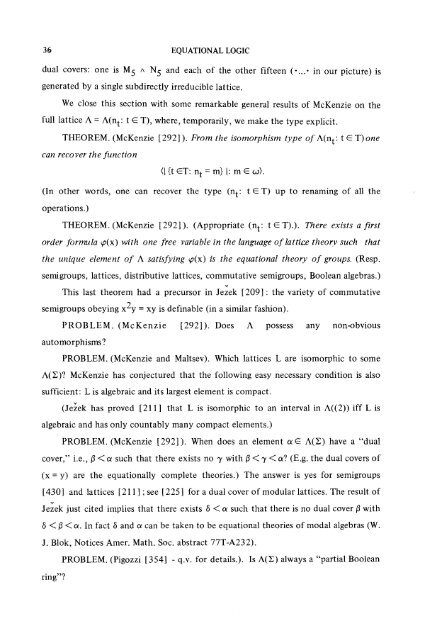Survey 1979: Equational Logic - Department of Mathematics ...
Survey 1979: Equational Logic - Department of Mathematics ...
Survey 1979: Equational Logic - Department of Mathematics ...
You also want an ePaper? Increase the reach of your titles
YUMPU automatically turns print PDFs into web optimized ePapers that Google loves.
36 EQUATIONAL LOGIC<br />
dual covers: one is M 5 ^ N 5 and each <strong>of</strong> the other fifteen (-.... in our picture) is<br />
generated by a single subdirectly irreducible lattice.<br />
We close this section with some remarkable general results <strong>of</strong> McKenzie on the<br />
full lattice A = A(nt: t C T), where, temporarily, we make the type explicit.<br />
THEOREM. (McKenzie [292] ). From the isomorphism type <strong>of</strong> A(nt: t C T)one<br />
can recover the function<br />
(1 (t T: n t = m} I: m co).<br />
(In other words, one can recover the type (nt: t G T) up to renaming <strong>of</strong> all the<br />
operations.)<br />
THEOREM. (McKenzie [292]). (Appropriate (nt: t G T).). There exists a first<br />
order formula 0(x) with one free variable in the language <strong>of</strong> lattice theory such that<br />
the unique element <strong>of</strong> A satisfying 0(x) is the equational theory <strong>of</strong> groups. (Resp.<br />
semigroups, lattices, distributive lattices, commutative semigroups, Boolean algebras.)<br />
This last theorem had a precursor in Jeek [209]' the variety <strong>of</strong> commutative<br />
semigroups obeying x2y = xy is definable (in a similar fashion).<br />
PROBLEM. (McKenzie [292]). Does A possess any non-obvious<br />
automorphisms 9.<br />
PROBLEM. (McKenzie and Maltsev). Which lattices L are isomorphic to some<br />
A(Z)? McKenzie has conjectured that the following easy necessary condition is also<br />
sufficient: L is algebraic and its largest element is compact.<br />
(Je,ek has proved [211 ] that L is isomorphic to an interval in A((2)) iff L is<br />
algebraic and has only countably many compact elements.)<br />
PROBLEM. (McKenzie [292]). When does an element tx C A(Z) have a "dual<br />
cover," i.e., 13 < tx such that there exists no 3' with 13 < 3' ix? (E.g. the dual covers <strong>of</strong><br />
(x = y) are the equationally complete theories.) The answer is yes for semigroups<br />
[430] and lattices [211 ]; see [225] for a dual cover <strong>of</strong> modular lattices. The result <strong>of</strong><br />
Je,ek just cited implies that there exists b tx such that there is no dual cover t3 with<br />
b 13<br />
ix. In fact and tx can be taken to be equational theories <strong>of</strong> modal algebras (W.<br />
J. Blok, Notices Amer. Math. Soc. abstract 77T-A232).<br />
ring"9,<br />
PROBLEM. (Pigozzi [354] - q.v. for details.). Is A(Z) always a "partial Boolean

















